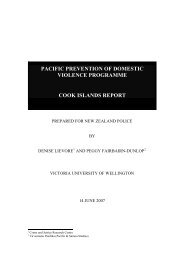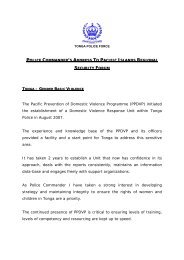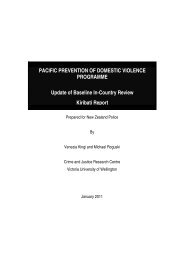Evidence Preservation in Sexual Assault: Between the Crime Scene ...
Evidence Preservation in Sexual Assault: Between the Crime Scene ...
Evidence Preservation in Sexual Assault: Between the Crime Scene ...
Create successful ePaper yourself
Turn your PDF publications into a flip-book with our unique Google optimized e-Paper software.
PACIFIC POLICE DEVELOPMENT PROGRAM<br />
<strong>Evidence</strong> <strong>Preservation</strong><br />
<strong>in</strong> <strong>Sexual</strong> <strong>Assault</strong>:<br />
<strong>Between</strong> <strong>the</strong> <strong>Crime</strong> <strong>Scene</strong> and <strong>the</strong><br />
Medical Exam<strong>in</strong>ation<br />
Pacific Police Development<br />
Program<br />
Global Justice Solutions
PACIFIC POLICE DEVELOPMENT PROGRAM<br />
LOCARD’S PRINCIPLE<br />
VICTIM<br />
CRIME SCENE OFFENDER
PACIFIC POLICE DEVELOPMENT PROGRAM<br />
<strong>Evidence</strong> <strong>Preservation</strong><br />
• At <strong>the</strong> scene of <strong>the</strong> crime<br />
• On <strong>the</strong> offender’s body and cloth<strong>in</strong>g<br />
• At <strong>the</strong> offender’s home or his car<br />
• On <strong>the</strong> victim of an assault and on her cloth<strong>in</strong>g<br />
• Class Characteristic <strong>Evidence</strong><br />
– Cannot be positively identified to a specific source,<br />
e.g.. hairs, blood, soil, fibres<br />
• Individual Characteristic <strong>Evidence</strong><br />
– Can be positively identified with a specific source,<br />
e.g.. f<strong>in</strong>gerpr<strong>in</strong>ts, DNA, specific microscopic cut and<br />
tear matches <strong>in</strong> cloth<strong>in</strong>g, videos and o<strong>the</strong>r record<strong>in</strong>gs<br />
of assault
PACIFIC POLICE DEVELOPMENT PROGRAM<br />
Tim<strong>in</strong>g is Important<br />
• Physical or trace evidence is rapidly lost from a victim’s<br />
body<br />
• Less than 72 hours s<strong>in</strong>ce sexual assault<br />
– Immediate medical exam<strong>in</strong>ation<br />
• More than 72 hours<br />
– Medical appo<strong>in</strong>tment as soon as possible but if<br />
overnight could wait until <strong>the</strong> follow<strong>in</strong>g day<br />
• More than two weeks<br />
– Medical appo<strong>in</strong>tment for health reasons, but<br />
unlikely to be forensically helpful
PACIFIC POLICE DEVELOPMENT PROGRAM<br />
VICTIM/PATIENT CONSENT<br />
• Doctors will always require <strong>the</strong> consent of<br />
<strong>the</strong>ir patient before proceed<strong>in</strong>g unless <strong>the</strong>re<br />
is a life threaten<strong>in</strong>g situation <strong>in</strong> which <strong>the</strong>y<br />
can proceed from a duty of care to <strong>the</strong>ir<br />
patient<br />
• Informed consent is required before<br />
perform<strong>in</strong>g an exam<strong>in</strong>ation for forensic<br />
purposes
PACIFIC POLICE DEVELOPMENT PROGRAM<br />
Deal<strong>in</strong>g with Injuries<br />
The Police Role is to arrange a medical exam<strong>in</strong>ation<br />
• Immediate treatment if <strong>in</strong>juries are severe<br />
• Mild – moderate <strong>in</strong>juries will also require medical<br />
review and medical exam<strong>in</strong>ation for forensic<br />
purposes<br />
• Injuries may be medically trivial but forensically<br />
significant<br />
• Police may assist with forensic photography of<br />
general (non-genital) <strong>in</strong>juries<br />
• (Injury <strong>in</strong>terpretation will be discussed separately)
PACIFIC POLICE DEVELOPMENT PROGRAM<br />
Preserv<strong>in</strong>g Forensic <strong>Evidence</strong>
PACIFIC POLICE DEVELOPMENT PROGRAM<br />
Physical or Trace <strong>Evidence</strong><br />
• Hairs/fibres<br />
• Debris such as foliage<br />
• Sand and soil<br />
• Condoms<br />
• Lubricant<br />
• Drop sheet to collect trace evidence that falls from<br />
cloth<strong>in</strong>g dur<strong>in</strong>g undress<strong>in</strong>g<br />
• Cloth<strong>in</strong>g<br />
– Tears<br />
– Cuts<br />
– Sta<strong>in</strong>s
PACIFIC POLICE DEVELOPMENT PROGRAM<br />
Body fluids from Offender<br />
• Semen can be tested with a biological kit<br />
check<strong>in</strong>g for acid phosphatase<br />
• Spermatozoa can be detected by microscopy<br />
• Saliva can be tested with a biological kit test<strong>in</strong>g<br />
for amylase<br />
• Blood can be tested for <strong>the</strong> blood group ABO and<br />
Rhesus positive or negative<br />
• DNA analysis
PACIFIC POLICE DEVELOPMENT PROGRAM<br />
DNA<br />
• Deoxyribonucleic acid<br />
• Is <strong>the</strong> genetic material found with<strong>in</strong> <strong>the</strong> nucleus of<br />
<strong>the</strong> cells of all liv<strong>in</strong>g tissues<br />
• DNA carries <strong>the</strong> code of all <strong>the</strong> genetic material<br />
that determ<strong>in</strong>es <strong>the</strong> unique characteristics of a<br />
human or animal<br />
• Half is passed from <strong>the</strong> mo<strong>the</strong>r (maternal) and<br />
half from <strong>the</strong> fa<strong>the</strong>r (paternal) DNA<br />
• Only an identical tw<strong>in</strong> will have exactly <strong>the</strong> same<br />
DNA profile.
PACIFIC POLICE DEVELOPMENT PROGRAM<br />
DNA Analysis<br />
• T<strong>in</strong>y amounts of DNA such as those shed from<br />
cells from <strong>the</strong> human body are processed by<br />
amplification to a larger amount, <strong>the</strong>n analysed<br />
for <strong>the</strong> specific DNA profile.<br />
• A number of sites on each strand of DNA are<br />
analysed to determ<strong>in</strong>e <strong>the</strong> unique profile of <strong>the</strong><br />
<strong>in</strong>dividual.<br />
• The chances of f<strong>in</strong>d<strong>in</strong>g <strong>the</strong> same profile on two<br />
different people is extremely unlikely, less than<br />
1: 1000,000,000
PACIFIC POLICE DEVELOPMENT PROGRAM<br />
DNA <strong>in</strong> <strong>Sexual</strong> <strong>Assault</strong>:<br />
Offender DNA<br />
• Establishes <strong>the</strong> presence of <strong>the</strong> offender at <strong>the</strong><br />
crime scene<br />
• Establishes contact between <strong>the</strong> offender and <strong>the</strong><br />
victim<br />
• May establish that penetration occurred<br />
• Does not determ<strong>in</strong>e if penetration was consensual
PACIFIC POLICE DEVELOPMENT PROGRAM<br />
DNA <strong>in</strong> <strong>Sexual</strong> <strong>Assault</strong><br />
• Specimens are collected from any sites where<br />
offender DNA may be present<br />
• Forensic specimens from a victim are collected by<br />
<strong>the</strong> doctor<br />
Reference Samples<br />
• Include reference DNA buccal swab from <strong>the</strong><br />
<strong>in</strong>side surface of <strong>the</strong> cheek of <strong>the</strong> victim<br />
• May need to collect reference DNA from victim’s<br />
usual sexual partner
PACIFIC POLICE DEVELOPMENT PROGRAM<br />
• DNA is not visible<br />
Remember<br />
• Trace evidence is transient<br />
• It is collected from <strong>the</strong> possible sites of contact<br />
with <strong>the</strong> offender<br />
• It is easily missed, lost, destroyed, decayed and<br />
contam<strong>in</strong>ated<br />
• It is also a powerful tool to assist with a police<br />
<strong>in</strong>vestigation
PACIFIC POLICE DEVELOPMENT PROGRAM<br />
Examples from a crime scene<br />
• Cigarette end<br />
• Edge of a glass or bottle<br />
• Handle of a weapon<br />
• Door handle<br />
• Bedd<strong>in</strong>g<br />
• Condom
PACIFIC POLICE DEVELOPMENT PROGRAM<br />
Examples from a victim collected by a doctor<br />
• Scrap<strong>in</strong>gs from <strong>the</strong> under-surface of <strong>the</strong> f<strong>in</strong>ger nails of <strong>the</strong><br />
victim if she scratched <strong>the</strong> offender<br />
• Swabs from any area kissed or licked by <strong>the</strong> offender<br />
– lips, neck, breasts, bite marks<br />
• Oral swab from <strong>the</strong> victim’s mouth if <strong>the</strong>re was oral<br />
penetration<br />
• Swab from <strong>the</strong> external genitalia and from with<strong>in</strong> <strong>the</strong><br />
vag<strong>in</strong>a if <strong>the</strong>re was vag<strong>in</strong>al penetration<br />
• Swab from <strong>the</strong> peri-anal region and anal canal if <strong>the</strong>re was<br />
anal penetration
PACIFIC POLICE DEVELOPMENT PROGRAM<br />
How long does sperm last?<br />
• In <strong>the</strong> mouth 6-24hours<br />
• Around <strong>the</strong> anus up to 48hours<br />
• In <strong>the</strong> vag<strong>in</strong>a up to 72 hours<br />
• Perhaps longer at <strong>the</strong> cervix (neck of <strong>the</strong> womb or<br />
uterus)<br />
• On <strong>the</strong> sk<strong>in</strong>, uncerta<strong>in</strong>, but sperm have been found<br />
even after wash<strong>in</strong>g<br />
• Sperm have been found on cloth<strong>in</strong>g after<br />
launder<strong>in</strong>g
PACIFIC POLICE DEVELOPMENT PROGRAM<br />
Information to avoid loss of evidence<br />
• Avoid eat<strong>in</strong>g, dr<strong>in</strong>k<strong>in</strong>g, r<strong>in</strong>s<strong>in</strong>g mouth, brush<strong>in</strong>g<br />
teeth, until a specimen is collected after oral<br />
assault<br />
• Avoid bath<strong>in</strong>g or shower<strong>in</strong>g<br />
• Avoid pass<strong>in</strong>g first ur<strong>in</strong>e after a penile vag<strong>in</strong>al<br />
assault until a specimen of ur<strong>in</strong>e or a swab of <strong>the</strong><br />
genitals is collected<br />
• Avoid defaecat<strong>in</strong>g after penile anal assault until<br />
peri-anal swab is collected
PACIFIC POLICE DEVELOPMENT PROGRAM<br />
Early or Prelim<strong>in</strong>ary <strong>Evidence</strong><br />
• Non-<strong>in</strong>timate specimens that can be<br />
collected by <strong>the</strong> victim or police prior to<br />
see<strong>in</strong>g <strong>the</strong> doctor<br />
• Prelim<strong>in</strong>ary specimens provide comfort for<br />
<strong>the</strong> victim while avoid<strong>in</strong>g loss of evidence
PACIFIC POLICE DEVELOPMENT PROGRAM<br />
Examples of Prelim<strong>in</strong>ary<br />
Specimens<br />
• Oral swabs, oral r<strong>in</strong>se or ‘spit’ after oral<br />
assault<br />
• First void ur<strong>in</strong>e or external genital swab<br />
collected by <strong>the</strong> victim after vag<strong>in</strong>al assault<br />
• Peri-anal swab collected by <strong>the</strong> victim after<br />
an anal assault
PACIFIC POLICE DEVELOPMENT PROGRAM<br />
<strong>Sexual</strong> <strong>Assault</strong> <strong>Evidence</strong> Kits<br />
• Police and/or hospital need to ensure<br />
availability of forensic kits for <strong>the</strong> medical<br />
exam<strong>in</strong>ation<br />
• Not all samples need to be collected<br />
• Consider <strong>the</strong> facts of <strong>the</strong> case
PACIFIC POLICE DEVELOPMENT PROGRAM<br />
Avoid<strong>in</strong>g contam<strong>in</strong>ation<br />
• From police<br />
• From doctors<br />
• From laboratory staff<br />
• Always wear gloves when collect<strong>in</strong>g swabs or specimens<br />
• Wear face masks at a crime scene<br />
• Avoid wash<strong>in</strong>g or touch<strong>in</strong>g areas of <strong>the</strong> victim’s body which<br />
may require swabb<strong>in</strong>g<br />
• Clean <strong>the</strong> exam<strong>in</strong>ation room thoroughly <strong>in</strong>clud<strong>in</strong>g handles,<br />
desk surfaces, pens<br />
• Avoid use of staples <strong>in</strong> packag<strong>in</strong>g that may <strong>in</strong>jure<br />
laboratory staff
PACIFIC POLICE DEVELOPMENT PROGRAM<br />
Avoid<strong>in</strong>g DNA degradation<br />
• DNA is readily lost <strong>in</strong> a moist hot environment or from<br />
prolonged exposure to sunlight<br />
• Once collected, swabs should be air-dried before stor<strong>in</strong>g.<br />
( Alternatively cut open edge of plastic cover<strong>in</strong>g sheath)<br />
• Ideally frozen < -18C<br />
– Alternatives refrigeration, or dry secure cool storage<br />
<strong>in</strong> a locked cupboard<br />
• Cloth<strong>in</strong>g stored <strong>in</strong> <strong>in</strong>dividual paper bags<br />
• Dry before seal<strong>in</strong>g and stor<strong>in</strong>g
PACIFIC POLICE DEVELOPMENT PROGRAM<br />
Cha<strong>in</strong> of Custody<br />
• Documentation is crucial<br />
• Details of collector, sample, date, time, person<br />
(victim) and passage of specimen<br />
• Tamper proof specimen seal<br />
• Include any <strong>in</strong>formation of relevance to <strong>the</strong><br />
laboratory such as <strong>the</strong> time s<strong>in</strong>ce assault, number<br />
of offenders<br />
• Must <strong>in</strong>clude doctor’s details if specimens<br />
collected by medical exam<strong>in</strong>er
PACIFIC POLICE DEVELOPMENT PROGRAM<br />
O<strong>the</strong>r <strong>Evidence</strong> <strong>Preservation</strong><br />
• Early security of <strong>the</strong> crime scene<br />
• Trace evidence from <strong>the</strong> alleged offender, but doctors will<br />
be less keen to be <strong>in</strong>volved unless <strong>the</strong>re is <strong>in</strong>formed<br />
consent from <strong>the</strong> offender. Some offenders may require<br />
medical treatment of <strong>the</strong>ir <strong>in</strong>juries.<br />
• Initial report or telephone call – opportunity of key worker<br />
(nurse, counsellor, crisis worker, police) to <strong>in</strong>form <strong>the</strong><br />
victim about preserv<strong>in</strong>g evidence<br />
• <strong>Sexual</strong>ly transmitted <strong>in</strong>fections are not useful evidence <strong>in</strong><br />
an adult but are useful <strong>in</strong> children
PACIFIC POLICE DEVELOPMENT PROGRAM<br />
• Cooperative efforts between <strong>the</strong> medical<br />
and law enforcement professions will<br />
streaml<strong>in</strong>e <strong>the</strong> victim management and<br />
evidence collection process
PACIFIC POLICE DEVELOPMENT PROGRAM<br />
References<br />
• Hazelwood and Burgess (editors), Practical<br />
Aspects of Rape Investigation : A Multidiscipl<strong>in</strong>ary<br />
Approach, CRC Press, Florida,<br />
2009.<br />
• <strong>Sexual</strong> <strong>Assault</strong> Resource Centre, Subiaco,<br />
Western Australia, SARC Manual, 2009.














